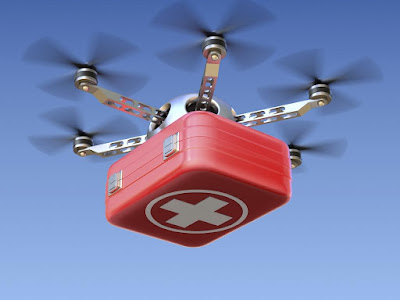Thursday, December 8, 2016
In findings announced yesterday, scientists from John's
Hopkins University took ordinary commercial drones, swapped out their cameras
for coolers and packed them with human plasma, platelets and blood cells. The
drones were found to deliver their cargo in usable condition after flights
lasting almost half an hour, at distances of up to 12 miles.
"For rural areas that lack access to nearby clinics, or
that may lack the infrastructure for collecting blood products or transporting
them on their own, drones can provide that access," says pathologist and
lead author of the paper Dr. Timothy Amukele.
Although earlier studies have confirmed that drone flights
do not affect the useful properties or microbe populations of human blood
products, those experiments were performed on small, vial-sized samples. Here,
the drones carried much larger quantities of blood, in the proportions and
packaging that doctors and medical technicians would actually use on patients,
with units purchased directly from the American Red Cross. Unlike Rwanda's
medical delivery drones, which were custom-made for blood product delivery by
Zipline, these experiments were completed with regular, commercially available
S900-model machines with minimal modification.
Post-flight, the samples were tested for cell rupture,
changes in pH, air bubbles and other damage that might indicate that the
packages had thawed out or otherwise become unsuitable for use in transfusions.
The samples were found to have arrived intact.
Although the test was performed in an unpopulated area, it
is speculated that drones might be useful not only for delivery of blood
products to rural medical facilities but also for distributing blood resources
through urban areas. John's Hopkins pathologist and research team leader Dr.
Timothy Armukele speculates that emergency medical teams may one day be able to
transfuse patients on the spot by calling for a drone to bring blood of the
appropriate type.
The details of the experiment have been published in the
latest issue of Transfusion.
Sources:
Press Release. "Study shows blood products unaffected
by drone trips" — Johns Hopkins Medicine, December 7, 2016
Kelsey D. Atherton. "Good news: It's safe to use drones
to fly blood around" — Popular Science, December 7, 2016
Timothy Armukele, Paul M. Ness, Aaron A.M. Tobian, Joan
Boyd, and Jeff Street. "Drone transportation of blood products" —
Transfusion, November 11, 2016
Amar Toor. "Country launches world's first national
drone delivery service with help from a Silicon Valley startup" — The
Verge, October 13, 2016
Timothy K. Amukele, Jeff Street, Karen Carroll, Heather
Miller, and Sean X. Zhang. "Drone Transport of Microbes in Blood and
Sputum Laboratory Specimens" — Journal of Clinical Microbiology, August
17, 2016


No comments:
Post a Comment